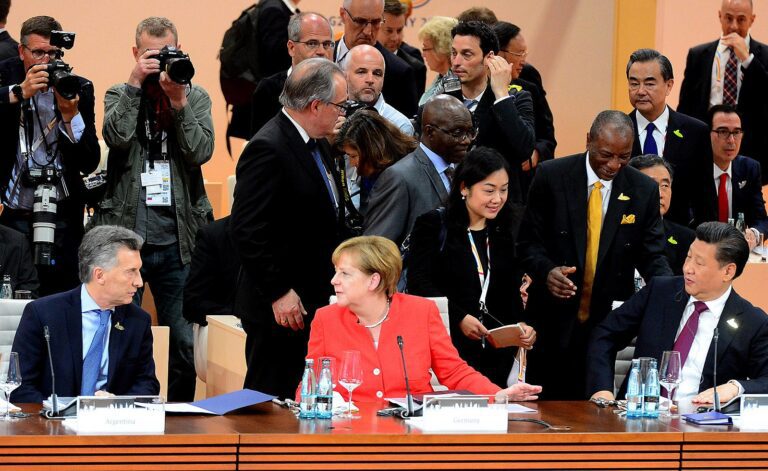
Big on principles and interests, the Strategy needs a dose of realism and focus more on capabilities in a rapidly changing world.
The recent publication of Germany’s ‘Strategy on China’ has generated significant interest in policy and business communities. Praised as demonstrating the formal departure from the “change through trade” approach of the Merkel era and the beginning of a new modus operandi in EU-China relations, the strategy has rightly been interpreted as an important milestone in Germany’s Zeitenwende – a promised reorientation in security and foreign policy announced by Chancellor Olaf Scholz in the aftermath of Russia’s invasion of Ukraine.
As with every China strategy, Germany’s has also encountered criticism. From lacking actionable policy prescriptions to the longstanding tension between commitments to universal human rights and economic interests in the Chinese market, the Strategy certainly reflects the complexity of transitioning towards a more farsighted German foreign policy vis-à-vis China. While most attention – and critique – has been leveled at the above, one issue that has largely been overlooked is the underlying worldview that drives most of the Strategy’s assumptions, assessments and conclusions.
Indeed, reading in between the lines, one cannot help but notice the Strategy is delivered the wrong way around. Instead of grounding Germany’s future relationship with China in a realistic assessment of China’s current role in the world to obtain realistic areas of engagement and competition, the strategy begins with assessing German-Chinese relations in a vacuum. Instead of understanding how China has been a driver of and integral to the systemic change we’ve been trying to understand and respond to, this approach puts the cart before the horse as if the past is a guide for the future.
An Outdated World View
As a consequence, the Strategy features several rather unrealistic assumptions about the world Germany finds itself in. Two are particularly noteworthy.
First, the document underestimates the agency and willingness of the Global South to find alternative positions on key global issues. For instance, throughout the document, we find 13 references to the “rules-based international order” but are left without a critical interpretation of what this term actually means. Many countries across the developing world have a very different view of how rules propagated by Europe and its partners apply to all but its supposedly most fervent supporters. From botched interventions in Libya to the catastrophic withdrawal from Afghanistan two years ago, amorphous references to liberal order and rules-based conduct leave many in the Global South with the bitter aftertaste of Western hypocrisy. Whether true or not, China’s diplomatic overtures have certainly benefitted from perceived failures of US- and European-led global order.
It is surely well and good for the Strategy to support the protection of the UN system, for example, but this can only bear fruit when couched in a realistic understanding of the state of contemporary multilateralism.
Appealing to the UN as bastion of universal human rights conveniently escapes the more complex reality that little of substance can be agreed on in the UN nowadays – from human rights issues in Xinjiang and Tibet to emerging areas of governance of outer space and the digital domain. It is no coincidence that the US and its allies have failed to debate the situation in Xinjiang in the UN Human Rights Council over the past year or that former UN High Commissioner for Human Rights, Michelle Bachelet, resigned after the publication of a report about state repression in the north-western autonomous region.
While the Strategy acknowledges “numerous countries are pivoting ever more towards China – and thereby impacting the effectiveness of our policies, including in the United Nations, ” this assertion is buried at the end of a section on global partnerships as if it were an afterthought rather than a crucial insight into the evolving global balance of power and China’s role therein.
While focusing on an ever more elusive “rules-based” order, it is not surprising that the Strategy ignores the role that alternative plurilateral arrangements play in China’s global strategy. A reference to the BRICS, for instance, is nowhere to be found despite almost 40 countries reportedly interested in fostering closer ties with the bloc – among them key geopolitical swing states such as Saudi Arabia that seek to diversify their economic and diplomatic ties beyond the West. Germany may well aim to engage third countries more actively in the realm of trade policy, but China is already the largest trading partner of around 120 countries. Speeding up the ratification of “negotiated agreements” with countries including Kenya and regional organizations such as MERCOSUR – which the Strategy calls for – might help countries in diversifying economic ties but will hardly dislodge China’s importance to most developing economies. Taken together, the Strategy should answer more critically whose order it is that Germany wants to uphold and how likely countries across the Global South will support such ambitions.
Germany’s Capability-Expectations Gap
Secondly and perhaps because of the above, the Strategy frequently expounds a mismatch between Germany’s intentions and capabilities. It is common for strategy documents to prioritize interests, objectives, and principles over capabilities for implementation while delegating capability-related issues to the military and defense policy communities. And yet, it is paramount to consider both during follow-up discussions.
For instance, the Strategy ambitiously proclaims Germany’s interest to “protect global public goods in the Indo-Pacific in the long term.” In reality, however, Germany will have to depend on allies to fulfil such obligations. Militarily, Europe continues to rely on the US and its alliance and basing network in Asia. It is clear that without Washington, Europe will stand on the side lines of any conflict over Taiwan or in the South China Sea. To put ambitions into perspective, the UK’s recent Integrated Review Refresh has already declared the UK’s Indo-Pacific Tilt as completed after only “deploying a UK Carrier Strike Group and two offshore patrol vessels to the region.” Symbolism abound, the question remains how Germany will square the obvious capability–expectations gap.
The provision of public goods of course goes beyond military means. And the Strategy’s emphasis on prioritizing German comparative advantages when dealing with third countries is laudable. Ultimately, however, it will take a lot of concerted effort among the G7 to rival China in any meaningful sense in areas that the developing world regards as important. Berlin might support various EU and G7 infrastructure and investment initiatives, for instance, but even combined they will hardly equal the amount that has been spend by China on the Belt and Road Initiative. Funding for infrastructure development will of course be welcomed across the developing world, but Germany will have to acknowledge the very real constraints the West will face in presenting a competitive and credible alternative to China.
And piggybacking on allies might not be as straightforward as the Strategy leads one to believe. In principle, Germany is right to call for WTO reform or to argue that “a successful approach to China requires Europe as a whole to bring its influence to bear.” But in the absence of an ideal world, such ideas will be difficult to realize. With the Inflation Reduction Act, for instance, the US has consolidated a shift towards strategic trade policy and industrial policy, reflecting the commitment to outcompete China in economic and technological sectors. In this context, multilateral cooperation on trade let alone another round of trade liberalization in the WTO will be difficult to achieve. Similarly, while Europe has moved towards challenging Beijing on certain issues more assertively, we are still far away from a joint EU-level China strategy that incorporates member states with closer ties to China such as Hungary while responding to China’s inroads into neighboring countries including Serbia. And Brexit has also made cooperation with the UK – a country with meaningful diplomatic networks in Asia and longstanding expertise on China – more difficult.
Waking Up to a New World
Despite the critique, Germany’s China Strategy is a step in the right direction. Taking stock of priorities in the bilateral relationship with China and beginning to articulate a framework for cooperating and competing with Beijing on key global issues is important. However, the underlying tendency to build policy solutions based on an outdated understanding of contemporary world politics will affect Germany’s ability to achieve some of the goals outlined in the Strategy.
Germany might no longer live in a world of yesterday, but one can hardly deny the impression of someone waking up to the light of dawn in a new world; a world that has changed more than Berlin would like to admit.
Written by
Lukas Fiala
LukasdkFialaLukas Fiala is Project Coordinator at China Foresight, LSE IDEAS, and a PhD International Relations candidate at LSE.


